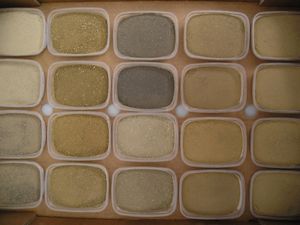تصنيف التربة
تصنيف التربة Soil classification لا يوجد إجماع دولي على تصنيف التربة. فقد وضعت معظم البلدان نظم التصنيف الخاصة بها تبعًا لاختلافات في تربتها. ووضعت منظمة الأغذية والزراعة، التابعة للأمم المتحدة (الفاو) نظامًا تصنيفيًا. وتستخدم نظام الفاو، بصفة عامة، الدول النامية التي لم تطور بعد نظم تصنيفها.
وكانت المحاولة الأولى لتصنيف التربة في روسيا في ثمانينيات القرن التاسع عشر. وقد اعتمد هذا التقسيم على الاعتقاد بأن نوع التربة يحدده، بشكل كبير، المناخ.
يعرف هذا النوع من التصنيف بالتصنيف النموذجي، وقد تطور خلال الخمسين عامًا الأولى من القرن العشرين. ولكن بعض العلماء اليوم يعتقد أن عوامل أخرى كثيرة تكون مسؤولة عن تكوين التربة واختلافاتها. وأدى هذا إلى أن يستبدل بالتصنيف النموذجي تصنيفات تعريفية تبنى على وصف التربة. وفي التصنيف التعريفي تجمع الترب المتشابهة لحد كبيرمعًا بدون وصف طريقة تشكيلها.
صيانة التربة


تسهم ترب الأرض الزراعية، وترب أراضي المراعي والغابات في توفير العديد من المنتجات وفي توفير مناطق الترويح، ولذلك ينبغي صيانتها. ويعمل حماة التربة على التأكد من الاستعمال الرشيد للتربة.
يستلزم الاستعمال الرشيد للأراضي الزراعية الحفاظ على مستوى عال من العناصر الغذائية والمواد العضوية في التربة المزروعة. ويضيف المزارعون مواد عضوية للتربة بحرث الأرض تحت بعض النباتات الخضراء. ويضيفون أيضًا مخصبات (سمادًا) ويديرون المحاصيل ليعوِّضوا العناصر الغذائية التي أزالتها النباتات النامية. وبالإضافة إلى ذلك فإن المزارعين يحرثون حقولهم ويزرعونها بطرق تمنع التعرية.
تعاني أراضي المراعي التي استخدمت بصورة جائرة أيضًا التعرية، حيث يقلل الإفراط في الرعي كمية النباتات، والمواد العضوية في التربة. وتصاب التربة بالتعرية بسهولة في حال وجود جذور نباتية قليلة لتثبيتها في مكانها. ويصون الفلاحون أراضي المراعي بتحديد الفترة الزمنية التي ترعى فيها المواشي في منطقة واحدة.
يجب أن تُصان أراضي الغابات أيضًا من التعرية. وفي بعض الحالات يترك قاطعو الأشجار أفرعًا غير مستعملة وأجزاء أخرى من الأشجار على أرض الغابة لتضيف موادّ عضوية للتربة. كما أنهم يعملون على تطوير مجموعات من الأشجار الكبيرة والصحية التي تعمل جذورها على صيانة التربة بتثبيتها في أماكنها ضد التعرية التي تسببها الريح والماء.
انظر أيضا
- AASHTO Soil Classification System
- Australian Soil Classification
- Canadian system of soil classification
- FAO soil classification
- International Committee on Anthropogenic Soils (ICOMANTH)
- Soil texture classification
- USDA soil taxonomy
- World Reference Base for Soil Resources
المصادر
قراءات إضافية
- Eswaran, H., Rice, T., Ahrens, R., & Stewart, B. A. (Eds.). (2002). Soil classification : a global desk reference. Boca Raton, Fla.: CRC Press.
النظام الدولي الحالي
- Buol, S.W., Southard, R.J., Graham, R.C., and McDaniel, P.A. (2003). Soil Genesis and Classification, 5th Edition. Iowa State Press - Blackwell, Ames, IA.
- Driessen, P., Deckers, J., Spaargaren, O., & Nachtergaele, F. (Eds.). (2001). Lecture notes on the major soils of the world. Rome: FAO.
- FAO. (1998). World Reference Base for Soil Resources. Rome: Food and Agriculture Organization of the United Nations.
نظم الطبيعية الحالية
- Agriculture Canada Expert Committee on Soil Survey. (1987). The Canadian system of soil classification (2nd ed.). Ottawa: Canadian Government Publishing Centre.
- Avery, B. W. (1980). Soil classification for England and Wales: higher categories. Cranfield, England: Cranfield University, Soil Survey & Land Research Centre.
- Baize, D., & Girard, M. C. (Eds.). (1995). Référentiel pédologique 1995. Paris: Institut National de la Recherche Agronomique.
- Baize, D., & Girard, M. C. (Eds.). (1998). A sound reference base for soils: The "Référentiel Pédologique" (English translation by Hodgson J.M., Eskenazi N.R., & Baize D. ed.). Paris: Institut National de la Recherche Agronomique.
- Hewitt, A. E. (1992). Soil classification in New Zealand: legacy and lessons. Australian Journal of Soil Research, 30, 843-854.
- Isbell, R. F. (1996). The Australian soil classification. Collingwood, Victoria, Australia: CSIRO.
- Soil Classification Working Group. (1991). Soil classification: a taxonomic system for South Africa. Pretoria: Department of Agricultural Development, RSA.
- Soil Survey Staff. (1999). Soil taxonomy: a basic system of soil classification for making and interpreting soil surveys (2nd ed.). Washington, DC: US Department of Agriculture Soil Conservation Service.
تقنية النظم الحالية
- Boorman, D. B., Hollis, J. M., & Lilly, A. (1995). Hydrology of soil types: a hydrologically-based classification of the soils of the United Kingdom (No. 126): UK Institute of Hydrology.
- Klingebiel, A. A., & Montgomery, P. H. (1961). Land capability classification. Washington, DC: US Government Printing Office.
- Sanchez, P. A., Palm, C. A., & Buol, S. W. (2003). Fertility capability soil classification: a tool to help assess soil quality in the tropics. Geoderma, 114(3-4), 157-185.
- American Society for Testing and Materials, 1985, D 2487-83, Classification of Soils for Engineering Purposes: Annual Book of ASTM Standards. Vol. 04.08, pp 395-408.
تنظيم في وقت سابق من حيث الأهمية تاريخية
- Baldwin, M., Kellogg, C. E., & Thorp, J. (1938). Soil classification. In Soils and men: Yearbook of agriculture (pp. 979-1001). Washington, DC: U.S. Department of Agriculture.
- Simonson, R. W. (1989). Historical aspects of soil survey and soil classification with emphasis on the United States, 1899-1970. Wageningen, NL: International Soil Reference and Information Centre (ISRIC).
مبادئ
- Butler, B. E. (1980). Soil classification for soil survey. Oxford: Oxford Science Publications.Science, 96,
- Cline, M. G. (1949). Basic principles of soil classification. Soil Science, 67(2), 81-91.
- Cline, M. G. (1963). Logic of the new system of soil classification. Soil 17-22.
- Webster, R. (1968). Fundamental objections to the 7th approximation. Journal of Soil Science, 19, 354-366.
- Terzaghi Karl (1924). Soil Mechanics in Engineering Practice, Wiley-Interscience; 3 Sub-edition (January 1996, ISBN: 0471086584)
تصنيف عددي
- McBratney, A. B., & de Gruijter, J. J. (1992). A continuum approach to soil classification by modified fuzzy k-means with extragrades. Journal of Soil Science, 43(1), 159-175.
